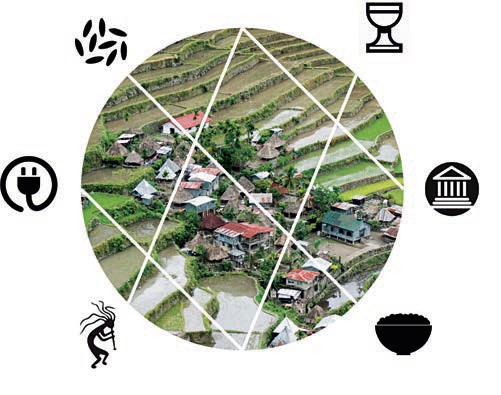Indigenous landscapes scatter the earth, engineered by climate and geography and, sometimes, by humans. The American National Parks, for example, derive their splendour after being shaped and reshaped by complex weather patterns over millions of years. The Pueblos of the Mesa Verde cliff dwellings in Colorado, or the Navajo in Arizona, are inextricably linked to the human effort and identity of the area. In an age of increasing globalisation, as societies become increasingly aware of other urbanisms and as weather patterns change, meaningful and monumental human-shaped places bear the threat of abandonment. It certainly is a cause for worry.
The engineered landscape of the Ifugao rice terraces of the Philippines are a complex agro-ecosystem with harvesting practices rooted in history. These terraces are a symbol of intense labour, state empowerment as well as a territorial claim amidst colonisation. The entire Ifugao community has a long history of living off and tending to these landscapes. In 16th-century Philippines, thousands of Spanish colonists thronged the islands and invaded the territory. Among the Cordillera Mountains on the island of Luzon in northern Philippines, the Ifugao people anticipated the Spanish arrival and engineered the natural landscape into productive agricultural terraces that spanned over 40,000 acres. This form of active resistance appears to have combated Spanish attempts to gain control over the region.

The social hierarchy of the Ifugao people is dependent on agriculture. Ifugao farmers own rice paddies and harvest rice and make up the elite of their society. Those who do not own rice fields are considered lower in social status. Property is passed on to a farmer’s first child and stays within the family. Traditional rituals use homemade rice wine to engage their deceased ancestors. In other words, rice has a special significance in Ifugao society. While rice paddies were privately owned, maintenance work and water rights were based on cooperative arrangements and common-pool resources. There are social contracts that allow farmers to help one another by conducting annual maintenance work such as planting and harvesting, repairing walls and irrigation channels and rebuilding terraces when necessary on the Cordillera Mountains.
Like most collective property rights arrangements, there were codes of conduct for daily practices. For example, if a farmer was unable to perform work on a given day, it was understood that he (males maintain the terraces) would provide already-prepared rice to feed the group who harvested that day. Because of the down-flowing nature of the water, communities that used the same channel of water shared agreed-upon management duties and this arrangement was part of a long tradition that fostered community relations and communication in the region.

PHOTO: M0N FEDERE MD (OWN WORK),/WIKIMEDIA COMMONS
The Ifugao rice terraces were designated a UNESCO World Heritage Site in 1995. This brought further attention to the region as a tourist destination and a site with great marketing potential as an exporting economy. The National Food Authority of the Philippine government has introduced commercial rice (developed by the International Rice Research Institute) into production. Data shows the dominance of non-local rice varieties in the region. Because rice has been commercialised, Ifugao farmers are able toprofit from the new rice.
However, producing the non-local rice varieties does not involve the traditional rice-harvesting rituals. This has impacted the rituals involving rice wine and deceased kinship, since Ifugao farmers now choose to focus on producing rice for profit.
Social cognition, or culture, in the region has changed to value the market economy. The women, who traditionally led rituals, are now ignored in the rice culture, as the men lead and support the exporting of rice. The rice production in the Philippines has steadily increased, while self-sufficiency has decreased since the 1990s, when the government began to focus on exporting the rice.
The Ifugao rice terraces will experience a loss of intangible heritage: their customs and traditional knowledge. The primary threat related to this site is that the cultural practice of rice harvesting is dying. Over hundreds of years, Ifugao rice farmers have passed on a very specific know-how. It is a speciality that newer generations are abandoning. They are seeking opportunities outside of their agricultural traditions to pursue an exciting urban lifestyle as well as economic stability, as the rice terraces are proving barely profitable.
The area hosts roughly one million visitors annually. A community-led effort, the Save the Ifugao Terraces Movement (SITMo), is harnessing the tourism industry to excite locals again about their traditional rice practices and rituals. SITMo designed ‘Rice Cycle Tours’, which demonstrate land preparation, planting and harvesting so that tours can only include fields planted with native rice varieties. Farmers guide tourists through rice production and perform their rice rituals for tourists.

PHOTO: CEPHOTO, UWE ARANAS; DIAGRAM COURTESY OF AUTHOR
Whose water?
In the 1960s, the Philippine government agency, the National Irrigation Administration (NIA), took control of all the irrigation systems within the Philippines. President Ferdinand Marcos, elected in 1965, appointed Alfredo Junio, an engineer and professor, as NIA Administrator. Under his leadership, the NIA bureaucratized water use in order to design and construct major dams and channels (Barker and Levine, 2012). The NIA trained its personnel to construct dams of select water channels (including a number of Ifugao water channels) to divert water to urban areas of the Philippines. The NIA also required farmers to pay the government for the maintenance of the dams and channels. The NIA still administers the payout process today and leaves the responsibility of repairs and maintenance to locals (Barker and Levine, 2012; Acabado, 2010). The NIA staff maintained its financial viability by focusing on irrigation service fee collections; however, the bureaucracy of collecting fees has impinged upon on-the-ground maintenance. Maintenance is deferred and affects the quality of the rice paddies. Dams leading to urban areas have redistributed Ifugao water away from the farmers and the local population to other Filipinos – without any compensation to the farmers.

Right: Rice paddies and the water system
The principle shift from cooperative water rights to government-as-owner has become a source of conflict among the Ifugao farmers. Now, it is “normal to see farmers guarding their irrigation channels with guns” (Acabado and Martin, 2015). Fields across the Ifugao region are threatened by the cross-contamination of Indonesian worms and snails. Natural disasters, such as typhoons and earthquakes, also threaten the physical landscape of the rice terraces. A 2011 typhoon caused several small landslides that buried segments of the terraces. Today, because of the bureaucratic nature of repairs, the terraces remain in disrepair. Furthermore, earthquakes cause shifts in waterways and water flows, redistributing harvesting water to the wrong small farm and wasting water. For a few years, these land issues forced UNESCO to de-list the site as a World Heritage Site.
The change in water ownership affected the local socio-political dynamic surrounding the Ifugao agricultural system and it is also shrinking the Ifugao’s agency over the terraces their ancestors created.
The government understands the importance of the UNESCO World Heritage Site inscription. So long as it has control of natural resources in the area, the government may choose to make unilateral moves on the site (without Ifugao input) such as: rapidly building roads and locating transit infrastructure to encourage tourism; imposing a new tax policy on crops and encouraging settlements in nearby areas for economic reasons.
If the Ifugao are again able to own and manage the water and land as they did in the past in a way characteristic to their centuries- old identity then:
1) They would not need to go through the bureaucratic hoops that defer maintenance.
2) Farmers would not need to prevent their water from flowing down the terraces in order to block others from gaining profit in rice production.
3) The society could reclaim their culture.
The challenge is that these three points assume the Ifugao are not already accustomed to the new government of the water, rice production and culture and that as a whole they would like to conserve their traditional customs.
Conclusion
Ifugao cultural identity is shifting not only because of state influence but also because of the Ifugao people’s willingness to change. In a society that increasingly values visibility, all of us have to choose between identities. Ifugao is at the cusp of losing its origins. The rice terraces are the nexus of Ifugao social relationships. What will become of the society if the state control of the water and focus on non-native rice production persists? If young generations continue to emigrate and if natural disasters strike the area? How can multiple sectors work together to ensure the practices protected since the 1500s are part of a lasting legacy in the region? Should UNESCO and the Philippine government have anything to do with the decision? Or should the Ifugao people organise themselves to shift the water policies and market-based policies and reclaim their cultural territory as they did centuries ago?



Comments (0)